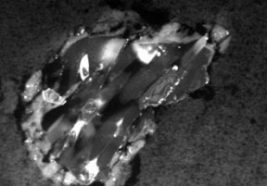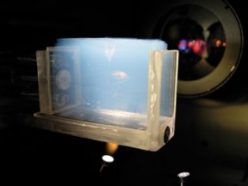Fiery Dust from an Icy Comet
Dust samples from a comet contain minerals that form only at high temperatures.
By Emily Sohn
When a space probe collected samples of dust from a comet, it returned to Earth with some surprises.
Even though comets are frozen balls of ice and dust, the dust samples contained minerals that form only at high temperatures. In other words, the comet somehow combined some of the hottest and coldest materials in the solar system.
 |
|
This grain, expelled by a comet, is made up of a mineral called olivine, which forms at high temperatures. The grain is about 2 micrometers across.
|
| NASA/JPL/University of Washington |
The dust in question came from the comet Wild 2. In 2004, a spacecraft called Stardust swooped within 236 kilometers (147 miles) of the comet’s core and collected grains of dust streaming off the object. Last January, a parachute delivered a canister of the material to the Utah desert (see “Capturing the Stuff of Space”).
Researchers from the University of Washington in Seattle sliced a few of the tiny grains into hundreds of pieces. Their analyses revealed a crystal called olivine, which forms at temperatures between 900 and 1,100 kelvins (1,160°F to 1,520°F). They also identified minerals that contain lots of titanium and aluminum. These minerals only form at temperatures above 1,400 kelvins (2,060°F).
 |
|
A block of frothy material called aerogel contains dust particles from Comet Wild 2.
|
| Don Brownlee, University of Washington |
Scientists have two possible explanations. One idea is that the dust particles formed at the center of the solar system when the sun was just a 10-million-year-old baby. The sun is now 4.6 billion years old.
In those early days, a cloud of gas, dust, and ice surrounded the sun. That’s where the planets formed. And, olivine and the other minerals could have formed in the steamy center as well.
The sun’s wind may have then pushed the particles to the chilly edges of the solar system, where they became part of newborn comets.
The second theory proposes that the minerals formed near a different star that happened to be in the sun’s neighborhood during the sun’s youth. This star’s wind could have then pushed the particles into our solar system. So, hot material from the nearby star may have been kicked into the territory of the comets.
Scientists are now planning to test whether Wild 2’s materials originally came from our solar system or from another star. The answer should help them explain how the comet developed such a hot-cold personality.—E. Sohn
Going Deeper:
Cowen, Ron. 2006. Comet sampler: Fire meets ice. Science News 169(March 25):182. Available at http://www.sciencenews.org/articles/20060325/fob7.asp .
Additional information about the Stardust space mission can be found at stardust.jpl.nasa.gov/home/index.html (NASA) and www.uwnews.org/article.asp?articleID=23093 (University of Washington).
McDonagh, Sorcha. 2004. Catching a comet’s tail. Science News for Kids (Jan. 14). Available at http://www.sciencenewsforkids.org/articles/20040114/Note2.asp .
Ramsayer, Kate. 2006. Capturing the stuff of space. Science News for Kids (Feb. 15). Available at http://www.sciencenewsforkids.org/articles/20060215/Feature1.asp .
Sohn, Emily. 2005. A smashing display. Science News for Kids (Aug. 24). Available at http://www.sciencenewsforkids.org/articles/20050824/Feature1.asp .
______. 2003. Sky dust keeps falling on your head. Science News for Kids (Aug. 13). Available at http://www.sciencenewsforkids.org/articles/20030813/Feature1.asp .







